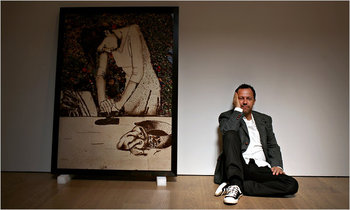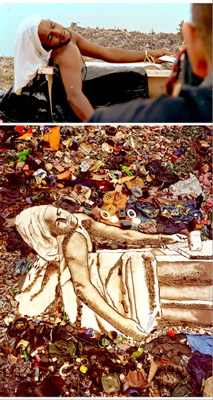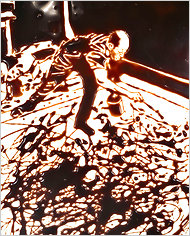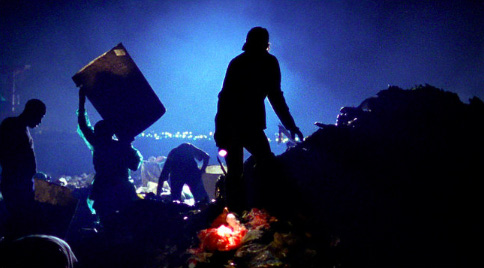
|
International Herald Tribune - Fri 22nd October 2010 |
| Todd Heisler/The New York Times; Vik Muniz with one of the portraits in his "Pictures of Garbage" series. |

Where Art Meets Trash And Transforms Life
By CAROL KINO
THE photographer Vik Muniz often says that while he considers himself an American artist, his use of imagery owes everything to Brazil, where he was born and raised.
"I'm a product of a military dictatorship," he said recently at his New York gallery, Sikkema Jenkins & Company. "Under a dictatorship, you cannot trust information or dispense it freely because of censorship. So Brazilians become very flexible in the use of metaphors. They learn to communicate with double meanings."
Certainly his photographs are filled with the visual equivalent of double entendres. At first each seems to present a familiar image or artwork. But examine the picture up close, and it turns out to be made from surprising mediums, like Bosco syrup, which Mr. Muniz once dribbled across vellum to recreate Hans Namuth's photograph of Jackson Pollock making a drip painting; peanut butter and jelly, from which he molded a Warholesque "Double Mona Lisa"; or plastic toy soldiers, which he used to recast a Civil War photograph of a boyish-looking private.
This penchant for multilayered imagery may be one reason Mr. Muniz, a puckish 48-year-old who has been an art world fixture for more than a decade, is now a celebrity in Brazil. In the last two years his traveling retrospective, simply called "Vik," has been in five cities there, achieving record attendance. He has also funneled much time and money into nonprofits (which have flourished in Brazil's democracy), most of which are located in Rio de Janeiro, and intended to provide education and job training for street children.
At the time of our interview, the voluble, charismatic Mr. Muniz had just flown in overnight from the São Paulo Biennale on a 48-hour tour of New York, where he oversaw the renovation of the Brooklyn studio where he lives part time (when not in Rio), checked in with his dealer and was an M.C. at a benefit gala for the nonprofit Brazil Foundation at the Metropolitan Museum of Art. There he was named a Unesco Goodwill Ambassador.
Now, as the star of "Waste Land," a touching documentary that opens on Friday after winning numerous film festival awards, he seems on the verge of reaching a broad audience in this country too.
The film, directed by Lucy Walker ("Blindsight," "Countdown to Zero"), tracks the development of a 2008 series of monumental photographic portraits made from trash. Called "Pictures of Garbage," they were created by Mr. Muniz in collaboration with the garbage pickers of Jardim Gramacho, a 321-acre open-air dump just outside Rio that is one of the largest landfills in Latin America.
This informal workforce - or catadores, as they are known - are the reason Brazil, with only a few municipal recycling programs, manages to reclaim a huge percentage of its trash, said Sonia Dias, the waste-picker specialist for Wiego, a global policy research group. This summer Brazil passed a law to eradicate open dumps and integrate the catadores into the recycling industry. Yet the catadores are still an underclass. The film tells the story of Mr. Muniz's efforts to help those at Jardim Gramacho take charge of their lives, while giving them a new perspective on the world through art.
It begins in Mr. Muniz's Brooklyn home. "I'm at this point in my career where I'm trying to step away from the realm of fine arts," he says to the camera, "because I think it's a very exclusive, very restrictive place to be. What I want to be able to do is to change the lives of people with the same materials they deal with every day."
He informs his wife at the time, the artist Janaina Tschäpe, that he intends to spend two years at Gramacho, working with the catadores. Mr. Muniz is then seen amid Gramacho's majestic mountains of trash meeting the catadores with Fabio Ghivelder. "I grew up poor," Mr. Muniz says. "Now I've reached the point where I want to give back."
The catadores in the film soon reveal themselves to be as personality-packed as Mr. Muniz. They include Tião Santos, president of the workers' cooperative Association of Collectors of the Metropolitan Landfill of Jardim Gramacho; the scholarly Zumbi, who has educated himself by reading discarded books; Suellem, a teenage mother who has worked at Gramacho and lived in its shantytown since her childhood; and Magna, who became a catador when she and her husband fell on hard times. Though their work may be grim and dangerous, many of them seem to have a crystal clear idea of its environmental worth. And, as Magna says, "It's better than turning tricks at Copacabana."
Mr. Muniz eventually transforms their images into classical portraits, which he models in his studio with their help, using garbage they have scavenged from Gramacho. (The catadores were paid for their time and the materials.) Suellem, posing with her two children, becomes a Renaissance Madonna; with Zumbi Muniz recreates Millet's "Sower"; and Tião sits in a bathtub like David's Marat awash, in a sea of filthy clothes, plastic bottles and abandoned toilet seats.

Top, Vik Muniz; above, Vik Muniz and Vik Muniz Studio
The photo, top, and finished piece, above, of Tião Santos posed as David's Marat.
By the film's end Tião's portrait has been sold at auction, and Mr. Muniz has donated his $50,000 take to the workers' cooperative. And the catadores have visited the Museu de Arte Moderna in Rio to see themselves in Mr. Muniz's 2009 retrospective. "Sometimes we see ourselves as so small," one tells reporters at the opening, "but people out there see us as so big, so beautiful."
Mr. Muniz has also acknowledged that with a twist of fortune he might have become a catador himself. "They just weren't born very lucky," he says in the film. "But we're going to change that."
Yet his own stars seem to have been remarkably well aligned. Although he grew up in a poor family in São Paulo, his habit of expressing himself with tiny hieroglyphic drawings won him a scholarship to an art school. At 18, buoyed by an intense fascination with perception and optics, he talked himself into a job with a billboard company and became something of an advertising wunderkind.
That career ended abruptly when he was shot in the leg on his way to his first black-tie gala. His assailant, to ensure that he didn't press charges, offered him cash. Mr. Muniz took the money and decided to try his luck in America.
By 1983 he was in New York, working as a framer and living in the East Village while its gallery scene was booming. When he happened across Jeff Koons's enigmatic vacuum cleaner and basketball sculptures at International With Monument, he said: "I realized that I could be an artist too. He was speaking my language."

Vik Muniz and the Estate of Hans Namuth/VAGA, NY
Mr. Muniz's re-creation of a photo of Jackson Pollock made with Bosco syrup.
A friend lent him a studio space, and Mr. Muniz began making his own objects, like a shiny shelf intended to gather dust, or a pre-Colombian drip coffee maker. In 1988 he had his first New York solo gallery show. Then he began experimenting with drawing and photography.
On a 1996 trip to St. Kitts he discovered the perfect blend of all three mediums when he befriended some families at a sugar plantation and took Polaroids of them. Back in New York, he tried to figure out what made the children look so luminous while their parents seemed so broken down. After realizing the difference was a lifetime spent working with sugar, he used the glittering grains to draw and form the children's portraits on black paper, and photographed the results. The Museum of Modern Art chose them for its 1997 "New Photography" roundup, and Mr. Muniz's career as a photographer was born.
"He was always interested in visual theory and the vernacular," said Brent Sikkema, his dealer. "But this was a defining moment."
The work's accessibility often leads art cognoscenti to dismiss Mr. Muniz, said Peter Boswell, a curator at the Miami Art Museum who organized "Vik Muniz: Reflex," a 2006 retrospective there. (It toured the United States, Canada and Mexico for two years, then went to Brazil in expanded form; it closed in August.) "Because Vik is so prolific, some people are tempted to write him off," Mr. Boswell said. "Even at the beginning, people were saying that it was just clever work that didn't have substance. But I think people who say that aren't looking very deeply. Vik's got a whole lot of substance, both within the work and behind the work, in the whole machinery that he has put into place."
And it's increasingly clear that Mr. Muniz has ambitions beyond the art world - something to do with alchemical transformation, not just of garbage into art, and art into cash, but also of people's lives.
In this he has been successful. Since the film wrapped, some of the catadores have found new jobs, and Mr. Muniz and the filmmakers have donated $276,000 to the cooperative, Mr. Ghivelder said, which has been used, among other things, to buy a truck and computers, found a library, provide capital funds for the organization and finance a small-business training program. (Another $50,000 from Mr. Muniz went to the catadores who posed for portraits.
The project also seems to have changed Mr. Muniz's perspective on imagery. "The really magical things are the ones that happen right in front of you," he said. "A lot of the time you keep looking for beauty, but it is already there. And if you look with a bit more intention, you see it."

Vik Muniz Studio
A still from Lucy Walker's "Waste Land."
